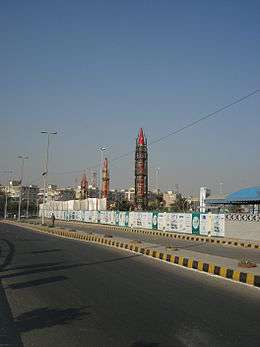Ghaznavi (missile)
| Ghaznavi Hatf-III | |
|---|---|
 Ghaznavi is the missile on the left | |
| Type | Short range ballistic missile (SRBM) |
| Place of origin | Pakistan |
| Service history | |
| In service | March 2004–Present [1] |
| Used by | Pakistan Army |
| Production history | |
| Designer | National Development Complex |
| Manufacturer | National Development Complex |
| No. built | 30 (2017 est.)[2] |
| Specifications | |
| Weight | 5,256 kg |
| Length | 9.64 m |
| Diameter | 0.88 m |
| Warhead | ~700kg of conventional HE/NE |
|
| |
| Engine | Single-stage solid fuel rocket motor |
| Propellant | Solid fuel |
Operational range | 290–320 km |
Launch platform | Transporter erector launcher (TEL) |
The Ghaznavi (Urdu:غزنوی; official codename: Hatf–III Ghaznavi[3]), is a hypersonic surface to surface short range ballistic missile designed and developed by the National Development Complex, in service with the Pakistan Army's strategic command since 2004.[4] With an optimal range of 290 km,[1] it is named after the 11th century Muslim Turkic conqueror Mahmud of Ghazni. The missile has a length of 9.64m, diameter of 0.99 m, launch weight of 5256 kg and is powered by a single stage solid fuel rocket motor.[1] It is believed influenced from a Chinese design, the M-11 (NATO reporting name: CSS-7).[1][5][6]
Design history
Initially, the Pakistan government was actively pushing for acquiring the M-11 missiles from China with the intention of a quick deployment.[7] Prime Minister Benazir Bhutto personally lobbied in China for the M-11 missiles, but was unable to do so due to intense pressure mounted by the United States and the MTCR's strict monitoring of prevention of the technology transfers of the missiles.[8] Development on Ghaznavi started in 1990s after the refusal of export of M-11 missiles from China to Pakistan.[7] The Ghaznavi was pursued alongside the Abdali program, and its features are extremely close to those of the Chinese M-11.[8] The Ghaznavi program contract was awarded to NDC.[4]
The Pakistan military officials consistently maintained that the Ghaznavi program is locally designed and indigenously built.[9] In 1995, its engine was successfully tested and was said to be a "major break-through in missile development in Pakistan".[9]
Tests and status
The Ghaznavi took its first spaceflight on 26 May 2002, at the height of the military standoff between India and Pakistan.[10] On 3 October 2003, the Ghaznavi was again successfully test fired from an undisclosed location, which was described by the military as "highly successful".[11] The Ghaznavi successfully reached its target and has a range of 290km (180mi), making it capable of striking several key targets within neighboring nuclear rival, India.[11] The Ghaznavi entered in the service in March 2004 and currently with the Pakistan Army.[1]
Its third test launched took place on 8 December 2004;[12] subsequent tests were conducted on 9 December 2006 another on 13 February 2008 and 8 May 2010; the 2008 test was believed to have concluded a winter training exercise of Pakistan's Army Strategic Force Command (ASFC).[1] In May 2012, one more successful test of the missile was conducted as part of a training exercise.[13]
During its development at the NDC, the program was named in the memory of Mahmud of Ghazni– the 10th century Turkic emperor who founded the Ghaznavid Empire and frequently invaded India.[7] The JS HQ, however, officially codenames the missile as "Hatf–III Ghaznavi".[7]
References
- 1 2 3 4 5 6 Missile Threat - Hatf 3: http://missilethreat.csis.org/missile/hatf-3-ghaznavi/
- ↑ https://books.google.com/books/about/The_Military_Balance_2017.html?id=Vk8-vgAACAAJ
- ↑ News desk (10 May 2012). "Pakistan successfully tests Hatf III (Ghaznavi) missile". GEO News, 2012. GEO News.
- 1 2 NTI staff writer. "NDC's secret work". Nuclear Threat Initiatives. Nuclear Threat Initiatives. Retrieved 26 December 2014.
- ↑ Pakistan Missile Update - 2003 Archived 1 December 2008 at the Wayback Machine.
- ↑ Jane's Strategic Weapon Systems
- 1 2 3 4 Khan, PA, Brigadier Feroz (2012). Eating Grass: the making of Pakistan bomb. Sanford, ca, u.s: Stanford University Press. p. 552. ISBN 9780804776011
- 1 2 Rajain, Arpit (2005). Nuclear deterrence in Southern Asia China, India, and Pakistan. Thousand Oaks, Calif.: Sage Publications. ISBN 8132103254.
- 1 2 Lodhi, PA, Lieutenant-General SFS (6 May 1998). "Pakistan's Missile Technology". Defence Journal, 1998. Retrieved 26 December 2014.
- ↑ Staff correspondence reporter (26 May 2002). "Pak tests Ghaznavi missile amid world condemnation". Rediff on the Net, 2002. Rediff on the Net. Retrieved 27 December 2014.
- 1 2 Naqvi, Syed Mohsin (3 October 2003). "Pakistan kicks off missile tests". CNN Producer Syed Mohsin Naqvi contributed to this report. CNN Pakistan, 2003. CNN Pakistan. Retrieved 27 December 2014.
- ↑ Lee, Xiao Feng (8 December 2004). "Pakistan test-fires short-range missile". China Daily, Pakistan. China Daily. Retrieved 27 December 2014.
- ↑ Joshua, Anita (10 May 2012). "Pak tests nuclear-capable Hatf-III ballistic missile". The Hindu. Chennai, India. Retrieved 10 May 2012.